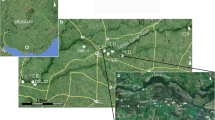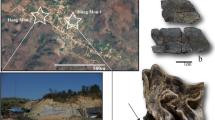Abstract
The chronology, sedimentary history, and paleoecology of the Tarija Basin (Bolivia), one of the richest Pleistocene mammalian sites in South America, are revised here based on a multidisciplinary study, including stratigraphy, sedimentology, geomorphology, paleontology, isotope geochemistry, and 14C geochronology. Previous studies have indicated a Middle Pleistocene age for this classic locality. We have been able to obtain a series of 14C dates encompassing all the fossil-bearing sequences previously studied in the Tarija Basin. The dated layers range in age from about 44,000 to 21,000 radiocarbon years before present (BP), indicating that the Tarija fauna is much younger than previously thought. Glacial advances correlated to marine isotopic stages (MIS) 4 and 2 (ca. 62 and 20 ka BP, respectively) are also documented at the base and at the very top of the Tarija–Padcaya succession, respectively, indicating that the Bolivian Altiplano was not dry but sustained an ice cap during the Last Glacial Maximum. The results of this multidisciplinary study enable us to redefine the chronological limits of the Tarija sequence and of its faunal assemblage and to shift this paleontological, paleoclimatological, and paleoecological framework to the time interval from MIS 4 to MIS 2.





Similar content being viewed by others
References
Argollo J, Mourguiart P (2000) Late Quaternary climate history of the Bolivian Altiplano. Quat Int 72:37–51
Bargo MS, Toledo N, Vizcaino SF (2006) Muzzle of South American Pleistocene Sloths (Xenarthra, Tardigrada). J Morphol 267:248–263
Cione AL, Tonni EP (1995) Chronostratigraphy and “Land-Mammal Ages” in the Cenozoic of Southern South America: principles, practices, and the “Uquian” problem. J Paleontol 69:135–159
Cione AL, Tonni EP (1999) Biostratigraphy and chronological scale of Uppermost Cenozoic in Pampean area, Argentina. In: Tonni EP, Cione AL (eds) Quaternary of South America and Antarctic Peninsula. Quat South Am Antarct Penins 12:23–51
Clapperton CM (1993) Quaternary geology and geomorphology. Elsevier Science, Amsterdam
Clapperton CM, Clayton JD, Benn DI, Marden CJ, Argollo J (1997) Late Quaternary advances and paleolakes highstands in the Bolivian Altiplano. Quat Int 38/39:49–59
Condomines M (1978) Age of the Olby–Laschamp geomagnetic polarity event. Nature 276:257–258
Crowson RA, Showers WJ, Wright EK, Hoering TC (1991) Preparation of phosphate samples for oxygen isotope analysis. Anal Chem 63:2379–2400
D’Agostino K, Seltzer GO, Baker PA, Fritz SC, Dunbar RB (2002) Late-Quaternary lowstands of Lake Titicaca: evidence from high resolution seismic data. Palaeogeogr Palaeoclimatol Palaeoecol 179:97–111
Deschamps CM, Tonni EP (1992) Los vertebrados del Pleistoceno Tardio–Holoceno del Arroyo Napostá Grande, Provincia de Buenos Aires. Aspectos paleoambientales. Ameghiniana 29:201–210
Fornari M, Risacher F, Feraud G (2001) Dating of paleolakes in the Central Altiplano of Bolivia. Palaeogeogr Palaeoclimatol Palaeoecol 172:269–282
Hoffstetter R (1963) La faune Pléistocène de Tarija (Bolivie). Note préliminaire. Bull Mus Natl Hist Nat Paris 35:194–203
Kent D, Hamming S, Turrin B (2002) Laschamp excursion at Mono Lake? Earth plan. Sci Lett 197:151–164
Lee Thorp J, Van der Merwe NJ (1987) Carbon isotope analysis of fossil bone apatite. S Afr J Sci 83:712–715
Liddicoat JC, Coe RS (1979) Mono Lake geomagnetic excursion. Geophys J Int 84:261–271
Longinelli A (1984) Oxygen isotopes in mammal bone phosphate—a new tool for paleohydrological and paleoclimatological research. Geochim Cosmochim Acta 48:385–390
MacFadden BJ (2000) Middle Pleistocene climate change recorded in fossil mammal teeth from Tarija, Bolivia, and upper limit of the Ensenadan land-mammal age. Quat Res 54:121–131
MacFadden BJ, Siles O, Zeitler P, Johnson NM, Campbell KE (1983) Magnetic polarity stratigraphy of the Middle Pleistocene (Ensenadan) Tarija Formation of Southern Bolivia. Quat Res 19:172–187
Marshall LG, Sempere T (1991) Fosiles y Facies de Bolivia, 1: Vertebrados. Rev Tec Yacim Pet Fisc Boliv 12:631–652
Marshall LG, Berta A, Hoffstetter R, Pascual R, Reig O, Bombin M, Mones A (1984) Mammals and stratigraphy: geochronology of the continental mammal-bearing Quaternary of South America. Palaeovertebrata, Mémoire Extraordinaire:1–76
Miall AD (1985) Architectural element analysis: a new method of facies analysis applied to fluvial deposits. Earth Sci Rev 22:261–308
Miall AD (1990) Principles of sedimentary basin analysis, 2nd edn. Springer, Berlin Heidelberg New York
Miall AD (1996) The geology of fluvial deposits. Springer, Berlin Heidelberg New York
Mourguiart P, Argollo J, Corrége T, Martin L, Montenegro ME, Sifeddine A, Wirrmann D (1997) Changements limnnologiques et climatologiques dans le basin du lac Titicaca (Bolivia), depuis 30.000 ans. Compte Rendu Academie de Science de la terre et des planets 325:139–146
Prado JL, Menegaz AN, Tonni EP, Salemme MC (1987) Los mamiferos de la fauna local Paso Otero (Pleistoceno Tardio), Provincia de Buenos Aires. Aspectos paleoambientales y bioestratigraficos. Ameghiniana 24:217–233
Sanchez-Chillon B, Alberdi MT, Leone G, Bonadonna FP, Stenni B, Longinelli A (1994) Oxygen isotopic composition of fossil equid tooth and bone phosphate—an archive of difficult interpretation. Palaeogeogr Palaeoclimatol Palaeoecol 107:317–328
Stehli FG, Webb SD (1985) The Great American biotic interchange. Plenum, New York
Sullivan CH, Krueger HW (1981) Carbon isotope analysis of separate chemical-phases in modern and fossil bone. Nature 292:333–335
Takai F, Mizuno T, Iwasaki Y, Tanaka K, Yoshida A (1982) Tarija mammal-bearing formation in Bolivia. Res Inst Evol Biol Tokyo 3:1–72
Takai F, Arozqueta B, Mizuno T, Yoshida A, Kondo H (1984) On fossil mammals from the Tarija Department, Southern Bolivia. The research Institute of Evolutionary Biology. Tokyo, 4:1–63
Tonni EP, Alberdi MT, Prado JL, Bargo MS, Cione AL (1992) Changes of mammal assemblages in the Pampean region (Argentina) and their relation with the Plio-Pleistocene boundary. Palaeogeogr Palaeoclimatol Palaeoecol 95:179–194
Zazzo A, Lecuyer C, Sheppard SMF, Grandjean P, Mariotti A (2004) Diagenesis and the reconstruction of paleoenvironments: a method to restore original δ18O values of carbonate and phosphate from fossil tooth enamel. Geochim Cosmochim Acta 68(10):2245–2258
Acknowledgment
We thank G. Ficcarelli for initiating the Italian Research Program on the Pleistocene/Holocene land mammals in South America and A. Longinelli because his precious advice substantially improved this manuscript. We are grateful to the staff of the Tarija Museo Nacional Paleontologico–Arquelogico for their technical support and friendship. We thank the Italian Embassy, Padre Lorenzo Calzavarini of the San Francisco monastery in Tarija and Dr. A. Paolillo (Crocetta del Montello) for their precious logistical help during field work in Bolivia. For revision of the English text, we thank Ian Heath, Sabrina Innocenti, Fritz Westover, and Ellen K. Herman. This work was financially supported by the Italian MIUR (COFIN 2003 to MC and LR) and Italian Foreign Ministry (to LR) grants as well as by grants from the Siena, Florence and Parma Universities.
Author information
Authors and Affiliations
Corresponding author
Rights and permissions
About this article
Cite this article
Coltorti, M., Abbazzi, L., Ferretti, M.P. et al. Last Glacial mammals in South America: a new scenario from the Tarija Basin (Bolivia). Naturwissenschaften 94, 288–299 (2007). https://doi.org/10.1007/s00114-006-0196-9
Received:
Revised:
Accepted:
Published:
Issue Date:
DOI: https://doi.org/10.1007/s00114-006-0196-9




